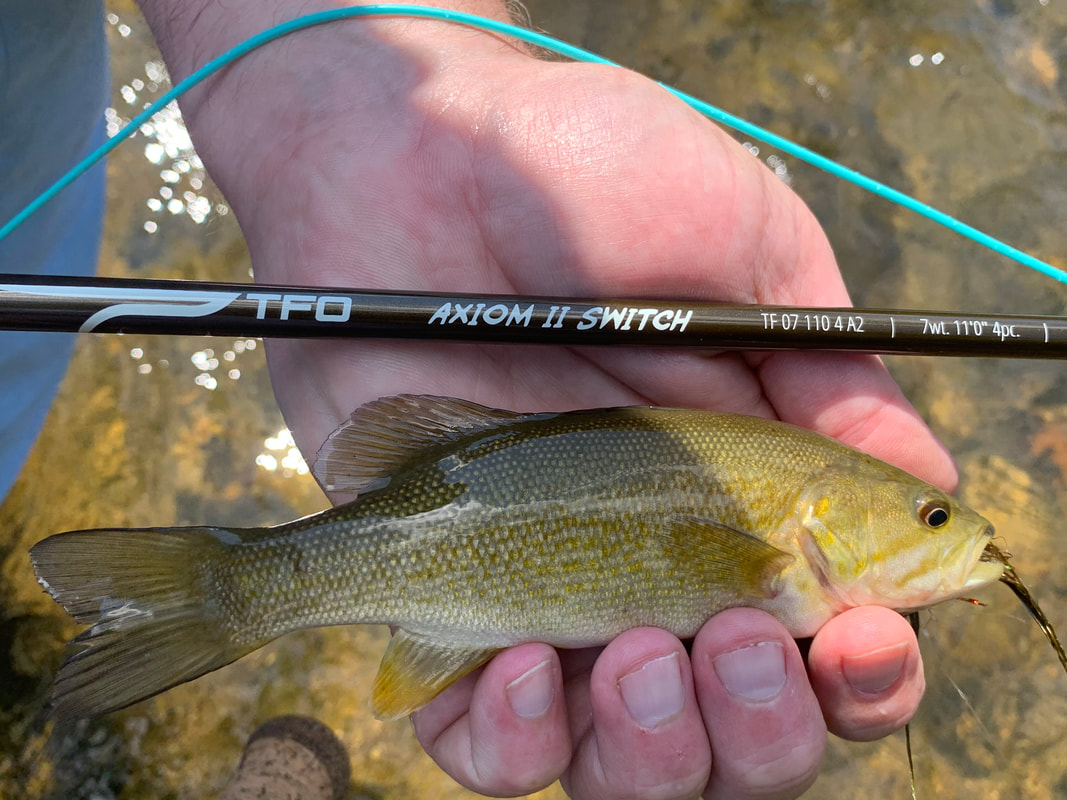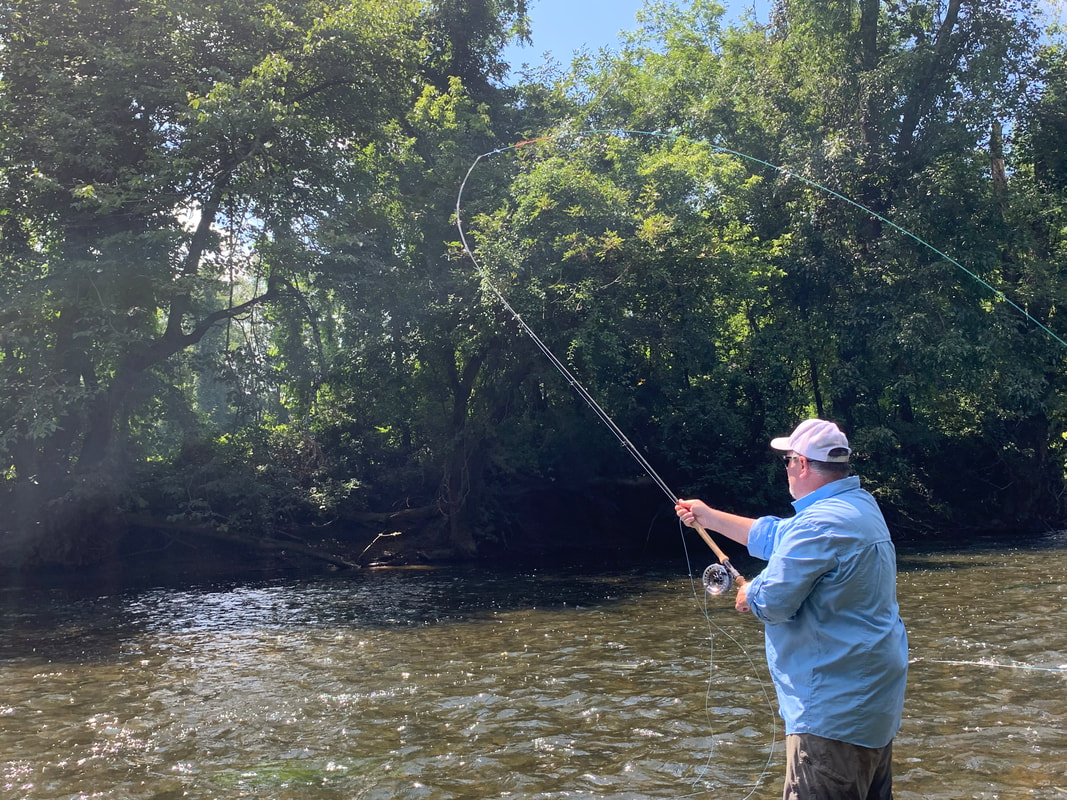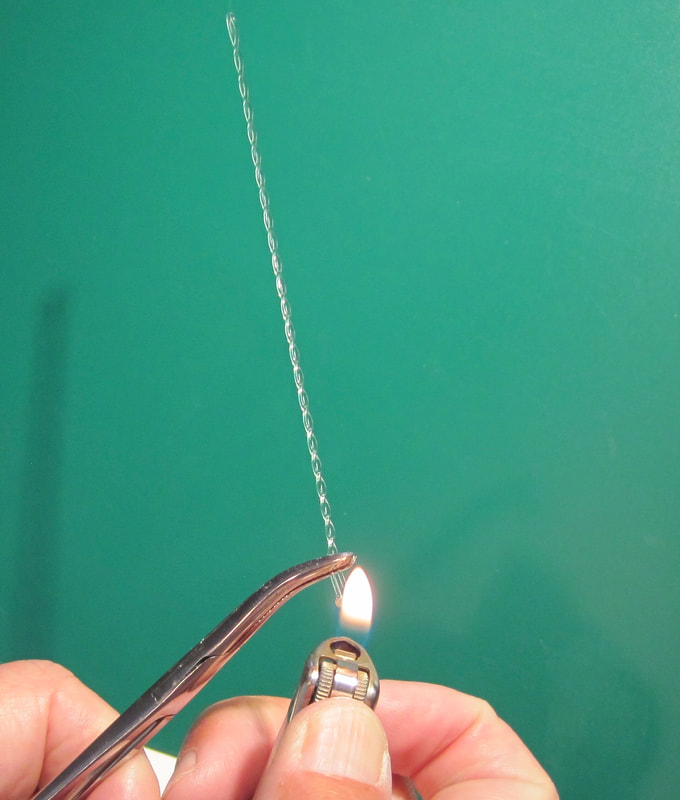|
I was recently asked to be a guest on Justin Lovell's podcast CB Fly Fishing. We talked a bit about Norvise, O'Neill's Fly Fishing and TFO. You can give it a listen here.
Tyler and I spent the afternoon this past Saturday on the river testing out some new TFO two handed rods. Steelhead season is right around the corner as is our O'Neill's Fly Fishing / Norvise Hosted Steelhead fishing trip. (BTW, we still have 3 spots open if you are interested contact me at [email protected]). We thought the dog days of Summer are a good time to get out, knock the rust off our 2 handed casts and get these new rods figured out. We hit the water with 2 new rods on Saturday, the Axiom 2 Switch in an 11' 7 weight (350 to 550 gr) and the brand new (not even released yet) LK Legacy 11'6" 7 weight (450 to 550 gr). The A2 Switch won basically every award a switch rod can since it's introduction close to a year ago and the LK Legacy is a brand new stick, only a select few people have had the chance to cast this rod at this point. Needless to say, we were excited to hit the water. While this was not a "fishing" outing it didn't seem right to be on the water without the opportunity to at least catch a fish. I believe it was John Geriach that said "in fly fishing there is a fine line between knowing what you are doing and standing in the river looking like a fool". Not wanting to look like fools, we put a small box of buggers and swimming nymphs together and headed to out favorite Smallmouth river. We had a conversation with Nick at TFO prior to this and got some guidelines from him on head weights for each rod. With this info we headed to the river armed with several Skagit heads (thanks Ed) the 2 rods and a pack of MOW tips. Simple leaders were tied at the truck and after rigging, we were ready to go. We started with the Axiom 2 Switch. Nick recommended a 450 Skagit head for this rod. That is what we started off with and I can tell you he was spot on. Shortly after a few practice casts I stripped off a bit of running line, loaded up a Snap T and let fly. The D loop and anchor jumped off the water like a Labrador in one of those Dock Dog competitions and at the end of the cast the running slapped the but section of the rod with the tell tale sign of the rod saying "oh yeah' there is more". The first thing I noticed about this rod is how light it is. It is feather light and balanced, tip positive, with the relatively light TFO BVK 3+ reel. The second thing I noticed about this rod is how thin the top grip is. The area where your top hand / thumb goes is REALLY hollowed out. The grip, in conjunction with the overall light weight of the package will make for a very comfortable set up that can be cast all day long. We tried several MOW tips from floating to 7.5' sink tip (where we Steelhead it is RARE we need to go past 7.5' of T11). and this rod handled them all. I am really looking forward to getting this rod out on the river this Fall and Winter. The second rod we put through it's paces is the new series form TFO called the LK Legacy. We have a couple of single handers in this series. We have been impressed with all of the LK rods so far, especially when you consider the price point. This was the 11' 6" rod rated for a 450 to 550 grain head. Nick had recommended a 500 or 525 grain head for this rod. We already had the 450 rigged up so we decided to give that a go. While it does say 450 gr on the butt section of the rod, I could not get the rod to do what I wanted it to do. We quickly switched to the 500 grain head, it was like night and day. This rod has a nice deep, progressive bend. It almost feels like the head is too heavy and I found myself needing to slow my stroke down a bit. Once we got the head weight and the stroke speed dialed in man, can this thing launch some line. It is funny, with the single hand and the 2 hand LK rods we have we had to search a bit for the right line combo. Both series I was a little hesitant at first as to weather I would like this rod series or not. Be it the single or two handed rods, I find myself liking this new series, liking them a lot! I guess this is why we take time to test rods and match lines so we can get the performance out of them that we need. I really think this new LK series of rods will be a force to be reckoned with. Remember that part about standing in the river looking like a fool??? Some of the action shots... This was a fun time on the water testing and matching some new gear. If you have any questions about these or any of the other great TFO products please feel free to contact us. Till next time,
Tight lines - Tim When Norm Norlander designed the NorVise it quickly became a classic tool to tie better quality, more consistent, and quicker flies. I think what we are all learning is that as we use the vise the versatility seems to be endless. I have had mine since the early years of its existence, and I am still finding new things it can do, with a few adaptations. Years ago I wanted to come up with an extended body for a Mayfly and a Stonefly pattern. I took a piece of yarn, put one end in the vise and began spinning. What I ended up with was a section of yarn that would, when folded back on itself produce a stiff tightly wound body. The upside for production tiers was you could create the bodies assembly line fashion for later use. This technique morphed into using two or three strands of 30 gauge coloured wire and using the same spinning technique (without folding the wire back) to produce a very finely banded segmentation on the shank of small nymphs; it almost appears woven. Flash forward to recent times and a new issue to deal with. With the advent of newer fly lines, there are a seemingly endless variety and an apparent specific application for every species! Saltwater lines are stiffer than Trout lines for example. Manufacturers are now offering Bass and Musky/Pike taper “warmer water” lines; lines that are stiffer than Trout lines, but softer than Saltwater lines. These lines are exceptional for throwing big flies, but the issue in more northern climes, with cold mornings or cold Fall days there is a lot of line memory when cold. As the day warms the issue does diminish. So, back to the NorVise......I have always used a stripping basket in my boat to keep the fly line under control and away from the “line grabbers” which seem to be present even on a clean casting deck. Recently, I added a foam insert in the bottom of the basket with “pegs” made of old 60lb monofilament I had laying around (30 years at least). So, cue the NorVise to create the "pegs". Step #1 as with the Mayfly/Stonefly bodies and the wire, I put one end of a 10-12” piece of mono in the jaws of the vise and spin the vise; holding the other end with forceps. Step #2 once the mono becomes difficult to spin, place scissors at the midpoint of the mono and fold the forceps end of the mono back to the vise. Once the scissors are removed you will notice that the mono wraps back on itself to form the stiff “peg”. Step #3 carefully remove the mono from the vise (so it doesn't unravel) and put both ends in the forceps and burn the tips together (not the loop end). Step #4 move the forceps to the desired length (3-4”) and re-cut and burn the end as in step #3. I use "pegs" 3" long. You can use other things for pegs such as golf tees, etc. but the flexibility of the mono gives less resistance on the line as it exits the stripping basket. TOP: The finished foam insert with the 9, 3" high "pegs". After poking holes in the foam base, I used a glue gun to hold the "pegs" in place.
BOTTOM: The foam insert in the bottom of the stripping basket. The basket That I use is a leaf bucket or laundry hamper that is about 24" high and 17" in diameter. I decided to use 9 "pegs" in my basket and it does prevent the line coiling and line memory issues to get me through the cool part of the day and prevent the inevitable tangles. I use a multitude of lines from the big 3 manufacturers and they all, to some degree, have the same line memory issue. Mike Corrigan Canada Here is yet another great use of the vise in a non fly tying application. There are many, many more. This post is yet another example of why the Norvise is "The Most Innovative Fly Tying System On The Market" . Till next time. Tight Lines - Tim |
Archives
June 2024
Categories
All
|

























 RSS Feed
RSS Feed
